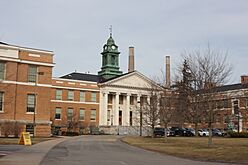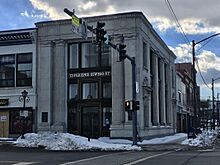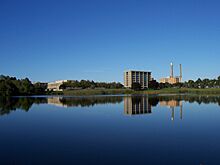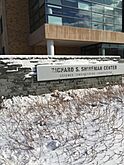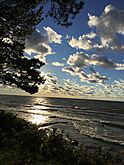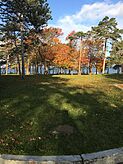State University of New York at Oswego facts for kids
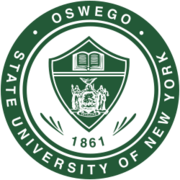 |
|
|
Former names
|
Oswego Primary Teachers Training School (1861–1942) Oswego State Teachers College (1942–1948) State University of New York College at Oswego (1948–2023) |
|---|---|
| Motto | To Learn, To Search, To Serve |
| Type | Public university |
| Established | 1861 |
|
Parent institution
|
State University of New York |
| Endowment | $71.8 million (2024) |
| President | Peter O. Nwosu |
|
Academic staff
|
600+ (2023) |
| Students | 6,756 (2023) |
| Undergraduates | 5,652 (2023) |
| Postgraduates | 1,104 (2023) |
| Location |
,
U.S.
|
| Campus | Rural, 700 acres (280 ha) |
| Colors | Hunter green and gold |
| Nickname | Lakers |
|
Sporting affiliations
|
NCAA Division III – SUNYAC |
 |
|
The State University of New York at Oswego (also known as SUNY Oswego or Oswego State) is a public university located in Oswego, New York, United States. It is home to 6,756 students and covers a large area of 700 acres. SUNY Oswego offers more than 120 different study programs for students. These programs are spread across four main colleges: the School of Business, the School of Communication, Media and the Arts, the School of Education, and the College of Liberal Arts and Sciences.
Contents
Discovering Oswego's Past
SUNY Oswego started in 1861 as the "Oswego Primary Teachers Training School." It was founded by Edward Austin Sheldon. He introduced a new way of teaching called the Oswego Movement, which changed education in America.
In 1942, the school became a college that could give out degrees. It was then called Oswego State Teachers College. In 1948, it became a founding member of the State University of New York (SUNY) system. By 1962, the college grew even more and started offering a wider range of subjects, becoming a liberal arts college.
Exploring the Campus
Most of the SUNY Oswego campus is located in the Town of Oswego. Some parts of the campus are also in Oswego City. The university was first built in the city of Oswego to train teachers.
In 1913, SUNY Oswego moved to its current spot right by Lake Ontario. This happened after Sheldon Hall was built. The campus today covers about 690 acres along the lake. The main buildings were designed by a famous architecture company called Skidmore, Owings & Merrill.
Today, the campus has 46 buildings. These include classrooms, labs, student housing, and sports facilities. The university has spent a lot of money to update and improve the campus. A major part of this is the Marano Campus Center Complex, which opened in 2007. This center is the main social spot for students. It includes the Deborah. F. Stanley Arena and Convocation Hall and many academic departments.
Tyler Art Gallery: A Creative Space
The Tyler Art Gallery is located inside Tyler Hall. This gallery shows art from local artists and traveling exhibits. It also features artwork by the university's teachers and students. Students even get to organize their own art show each year.
The gallery has a permanent collection of art from the 18th century to today. This includes drawings, prints, paintings, and sculptures from Europe, Africa, and America. There are also over 500 prints by American artists from the early 1900s.
Other Important Buildings
Across the road from the main campus is the south campus. Here you will find Laker Hall, which has indoor sports facilities and training rooms. There is also Romney Fieldhouse and several sports fields. The Rice Creek Field Station, covering over 400 acres, is also on the South Campus. It is used for studying nature and for public programs.
Many buildings on the west campus, like Hewitt Hall, Tyler Hall, Culkin Hall, Penfield Library, Lanigan Hall, and Mahar Hall, were built in the early 1970s.
University Programs and Studies
SUNY Oswego's programs are approved by the Middle States Commission. This means the university meets high standards for education. Many of its specific programs also have special approvals. For example, the business programs are approved by AACSB, and the education programs by CAEP. The engineering programs are approved by ABET. Oswego is also one of the few universities in New York where the art, music, and theater departments are all nationally approved.
Academic Schools and Colleges
SUNY Oswego is divided into four main schools and colleges:
- College of Liberal Arts and Sciences: This college offers many subjects like Biology, Chemistry, Computer Science, English, History, Math, Physics, Psychology, and Sociology.
- School of Business: Here, students can study Accounting, Finance, Marketing, and Human Resource Management.
- School of Communication, Media and the Arts: This school includes departments for Art, Communication Studies, Film Studies, Music, and Theatre.
- School of Education: This school helps students become teachers or work in counseling and educational leadership.
Penfield Library: A Hub for Learning
Penfield Library is the main library on campus. It is named after Lida S. Penfield, who used to lead the English department. The current library building opened in 1968 and is very large. The library holds many important collections, including historical papers and digitized documents.
Oswego Athletics: The Lakers
| Men's sports | Women's sports |
|---|---|
| Baseball | Basketball |
| Basketball | Cross country |
| Cross country | Field hockey |
| Golf | Ice hockey |
| Ice hockey | Lacrosse |
| Lacrosse | Soccer |
| Soccer | Softball |
| Swimming | Swimming |
| Tennis | Tennis |
| Track and field | Track and field |
| Wrestling | Volleyball |
The university has 14 different sports teams that compete against other colleges. These teams are called the Great Lakers, or just the Lakers. Oswego is part of NCAA Division III, and most teams play in the State University of New York Athletic Conference.
Oswego has a big rivalry with Plattsburgh State, especially in ice hockey. Fans used to throw bagels onto the ice when Oswego scored against Plattsburgh. This tradition stopped in 2006 because it caused penalties during games.
Winning a National Championship
On March 18, 2007, the Oswego State men's ice hockey team won the 2006–07 NCAA Division III ice hockey National Championship. This was the first national championship win for the school!
Clubs and Student Groups
Oswego has more than 180 clubs and organizations for students to join. These include the Men's Rugby team, the student TV station WTOP, and the student newspaper The Oswegonian. There is also the first-ever student-run volunteer ambulance corps (SAVAC) and the Oswego State Esports Association.
Greek Organizations
Students can also join Greek organizations, which are like social clubs called fraternities and sororities.
Campus Traditions
- Bridge Street Run – This is a tradition that happens in the spring semester. Students wear white T-shirts and visit different places along Bridge Street in Oswego. The college officially discourages this event. In 2015, the college started OzFest, a campus festival, to offer a different activity for students. However, some students still continue the Bridge Street Run tradition.
University Leaders
Here are some of the people who have led SUNY Oswego over the years:
- Edward Austin Sheldon (1st), 1861–1897
- Isaac B. Poucher (2nd), 1897–1913
- James C. Riggs (3rd), 1913–1933
- Ralph Waldo Swetman (4th), 1933–1947
- Harvey M. Rice (5th), 1947–1952
- Foster S. Brown (6th), 1952–1963
- James E. Perdue (7th), 1965–1977
- Virginia Radley (8th), 1977–1988
- Stephen L. Weber (9th), 1988–1995
- Deborah F. Stanley (10th) 1995–2021
- Mary C. Toale, Officer in Charge (interim), 2022–2023
- Peter O. Nwosu (11th), 2023–present
Famous Staff and Teachers
Some notable people have taught or worked at Oswego:
- Soma Mei Sheng Frazier, author and editor
- Kenneth O. Hall, former Governor-General of Jamaica
- Doug Lea, computer scientist
- Roy Lichtenstein, a famous pop artist, taught art here from 1958–1960
- Robert O'Connor, author of ... Soldiers
- Leigh Allison Wilson, author and creative writing professor
Notable Alumni
Many successful people have graduated from SUNY Oswego:
|
See also
 In Spanish: Universidad Estatal de Nueva York en Oswego para niños
In Spanish: Universidad Estatal de Nueva York en Oswego para niños


